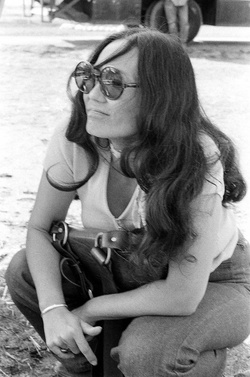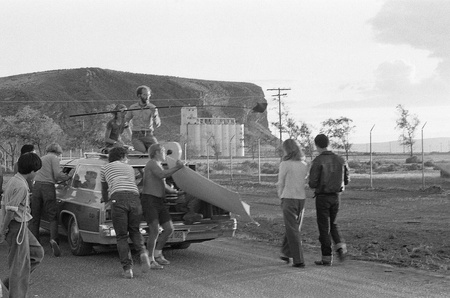In the summer of 1975, a film production about Manzanar woke some memories at Tule Lake.

The 1973 book Farewell to Manzanar is set in a very particular place. Derived from the experience of coauthor Jeanne Wakatsuki Houston, it describes one family’s incarceration during World War II at the Manzanar detention site in eastern California.
The Wakatsuki family were among about 120,000 Japanese Americans who, in 1942, were deported from their West Coast homes, forced to sell or give up much of their property, and made to live in inland camps under armed guard—an injustice rationalized at the time by claims about military security that were later proven false. Manzanar was one of the ten largest camps, housing more than 10,000 people at its peak population. Inmates lived in crowded, hastily built, poorly heated barracks in the harsh conditions of the arid Owens Valley, east of the Sierra Nevada mountain range.
Farewell to Manzanar, written as a personal story from the perspective of a young girl, was among the first works of literature to recount the wrongs of the incarceration to a large general audience.
Two years after the book’s publication, a Universal Pictures film production of the story, directed by John Korty, set out to portray the distinctive Manzanar social and physical environment: a crowded space under confinement, set in a big-sky desert landscape, with the highest peaks of the Sierra range rising to the west.
But by the time the production began in 1975, Manzanar had long been empty of barracks. The filmmakers couldn’t afford to build rows of new buildings for a set. Money was tight, especially after Universal Pictures downgraded the project from a feature film to a television movie.
So the production staff needed to find a camp that still looked like a camp.
They found what they needed in far northeastern California, at the former Tule Lake Segregation Center.
Among the ten large wartime camps, the U.S. War Relocation Administration placed only two within California: Tule Lake and Manzanar. The rest of the sites were much farther inland. Compared with Manzanar, the Tule Lake camp was bigger and even more remote. (The drive from San Francisco takes six hours now, and roads were worse in the 1940s.) Tule Lake had, and still has, a more politically disputed reputation: it was known for having become a “segregation” site as of 1943 for people who, through a flawed loyalty investigation process, were labeled as “disloyal.” Located in a high desert lake bed southeast of Klamath Falls, Oregon, the Tule Lake camp incarcerated more than 18,000 people at peak population, and also housed guards and civilian staff.
There are still a lot of barracks at Tule Lake. The place is remote and the economy sparse, so people tend to re-use structures rather than demolish and rebuild. Most of the barrack buildings were sold cheaply or given away to whoever would remove them. Converted sections of barracks can still be recognized as houses and sheds all over the surrounding three counties. But a large group of the sturdiest buildings were kept in place and incorporated into a farm town that formed on the site postwar. As of 1975, the town of Newell, California was a community with odd contours but ordinary purposes, built and adapted around the camp’s administrative and industrial core along Highway 139.
Despite an inland climate tending to dust storms and extreme temperatures, Tule Lake has productive farmland. It’s more habitable, for example, than the alkali wastes of the Topaz incarceration site in Utah. The Tule Lake Basin, when irrigated, grows rich crops in deep topsoil, including potatoes, onions, and horseradish. The lake itself, which still exists in reduced form, serves as a refuge for migratory birds, and as of the 1970s it was a popular destination for duck hunters.
For these reasons, the town of Newell maintained a lived-in core of original camp buildings. They could be made to pass for wartime Manzanar with the help of a set designer who knew too well how that should look: Robert Kinoshita, who himself had been in the Poston camp in Arizona.
So Farewell to Manzanar was shot primarily at Tule Lake. Memorably for director, cast, crew, and extras alike. By all accounts, filming at the Tule Lake camp site was an adventure for everyone in the production and an important journey for those who had personal or family histories of wartime incarceration.
© 2015 Martha Bridegam and Laurie Shigekuni






